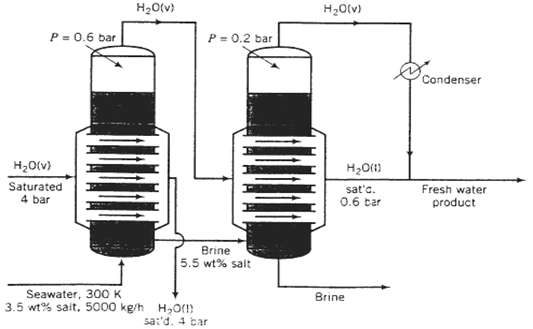A double-effect evaporator (two evaporators in series) is used to produce fresh water from seawater containing 3.5
Question:
A double-effect evaporator (two evaporators in series) is used to produce fresh water from seawater containing 3.5 wt% dissolved salts. A flowchart for the process is shown here. Seawater enters the first effect at 300 K at a rate of 5000kg/h, and saturated steam at 4.00bar absolute is fed into a tube bundle in the first effect. The steam condenses at 4.00bar, and the condensate is withdrawn at the saturation temperature corresponding to this pressure. The heat given up by the steam condensing in the tubes causes' water to evaporate from the brine solution at the pressure of 0.60bar maintained in the effect. The exiting brine contain5 5.5 wt% salt, the seam generated in the first effect is fed to a tube bundle in the second effect. The condensate from the bundle and the steam generated in the second effect at a pressure of 0.20bar constitute the fresh water produced in the process. In solving the problems to be given, assume that the brine solutions in both effects have the physical properties of pure water and that the effects operate adiabatically.
(a) Draw and label a flowchart of this process, giving the temperature and specific enthalpy of each stream.
(b) At what rate must steam be fed to the first effect?
(c) What is the production rate of fresh water? What is the salt concentration (weight percent) of the final brine solution?
(d) Why is it necessary that the pressure decrease from one effect to the next?
(e) Suppose a single-effect evaporator were used, operating at P 0.20bar. Calculate the feed rate of saturated steam at P = 4.00 bar that would be required to achieve the same production rate of fresh water. What more would you need to know to determine which process is moreeconomical?

Step by Step Answer:

Elementary Principles of Chemical Processes
ISBN: 978-0471720638
3rd Edition
Authors: Richard M. Felder, Ronald W. Rousseau





